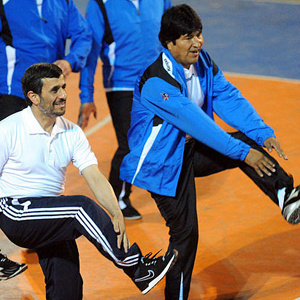Relations with Latin America: Opportunities, Impediments and Solutions

 This week, Mahmoud Ahmadinejad hosted Evo Morales and Hugo Chavez, presidents of Bolivia and Venezuela respectively, in Tehran. Dr. Mansour Moa’zzami, Iran’s former ambassador to Brazil, discusses the potentials and barriers to the expansion of ties with Latin American countries:
This week, Mahmoud Ahmadinejad hosted Evo Morales and Hugo Chavez, presidents of Bolivia and Venezuela respectively, in Tehran. Dr. Mansour Moa’zzami, Iran’s former ambassador to Brazil, discusses the potentials and barriers to the expansion of ties with Latin American countries:To discuss Iran-Latin American ties, we can begin with three basic questions: What are the potentials? What are the barriers? And what can we do considering the potentials and barriers?
Diplomatic visits between Iran and Latin American countries are per se constructive. In addition to political and ideological commonalities, Chavez’ and Morales’ trips provide Tehran an opportunity for investment. Latin America is an opportunity that should be grasped by Iranian leaders.
When we speak of Latin America, we are actually speaking of 34 countries with over 3 thousand billion dollars of GDP, a 350-million population, and a strategic position. Latin America is highly fertile for development. It can also be a lucrative market for Iran. Tehran has made heavy investments in this part of the world from long ago, and now it’s time to receive the dividends.
Iran and some Latin American countries share certain political principles, too: they oppose US domination and are critical toward a number of global trends. To higher or lesser degrees, most Latin American countries have supported Iran’s nuclear program. Iran can meanwhile serve as a role model for these countries. Democracy is becoming more and more institutionalized in Latin American states, with people liberated from juntas and colonial intervention. Iran can convey to these countries some lessons of its own history and some parts of its ideology.
Iran’s energy sector is vital in helping to find an economic foothold in Latin America. Energy-wise, Latin American countries are of two types: either they possess energy sources (like Venezuela), or are in dire need of energy for their development plans. This is a strong potential that in the case that it is realized, can pave the way for further investment by Iran.
However, there are some barriers, too. Distance is a major problem: Latin America is in the Western Hemisphere. There is also a lack of knowledge about each other’s potentials. The best way to tackle the latter problem is to ask the Foreign Ministry, cultural institutions, and the state-run media to introduce Latin America’s potentials to Iranians and overcome the information vacuum. Updated information about Brazil has already doubled the annual number of Iranian tourists visiting this country. Mutual visits could help in clarifying Iran’s image for Latin American countries.
The underdeveloped state of technology and economy in these countries is another problem. Except for Brazil, Chile and Argentina, other Latin American countries do not have powerful economies and technologically, have little to offer Iran.
What are the solutions? First and foremost, governmental bodies should work on a detailed Latin America strategy –a road map- which deals with each country separately. A plan carried out for Bolivia should differ from one customized for Nicaragua or Chile. And so should be the weight we give to each in our diplomacy.
The next point is that Iran should reaffirm its commitment to promises made. Contracts on building factories, housing complexes, roads etc., which have been heavily publicized, will strongly backfire if not materialized on the promised deadline.
Iran’s attitude toward the Latin American region should meanwhile focus on political economy, not economic politics. Projects carried out in Latin America should be cost-effective, economically reasonable, and based on a win-win principle. Our approach should also be geared toward long-term cooperation. It should not be individual-dependent, and has to continue even when Morales or Chavez leave office. And the last point: from a cultural aspect, Iran should focus on commonalities and seriously avoid differences, as there are strongly divergent attitudes toward cultural issues between Tehran and Latin America.

